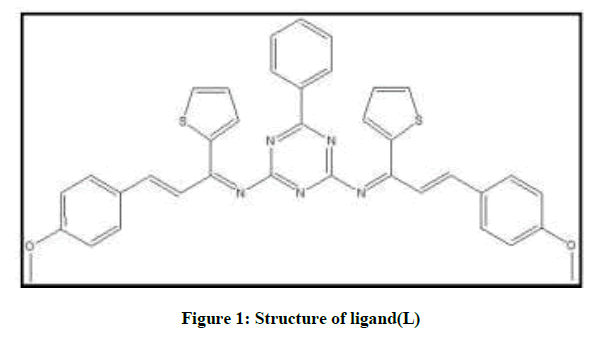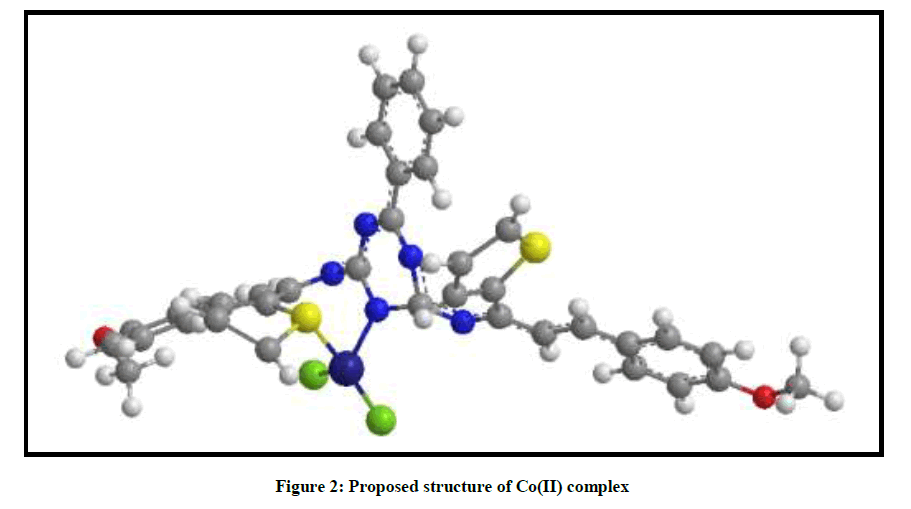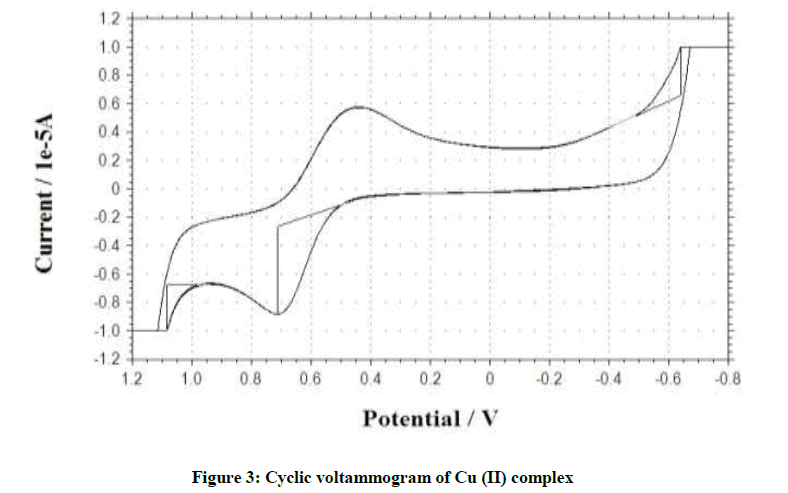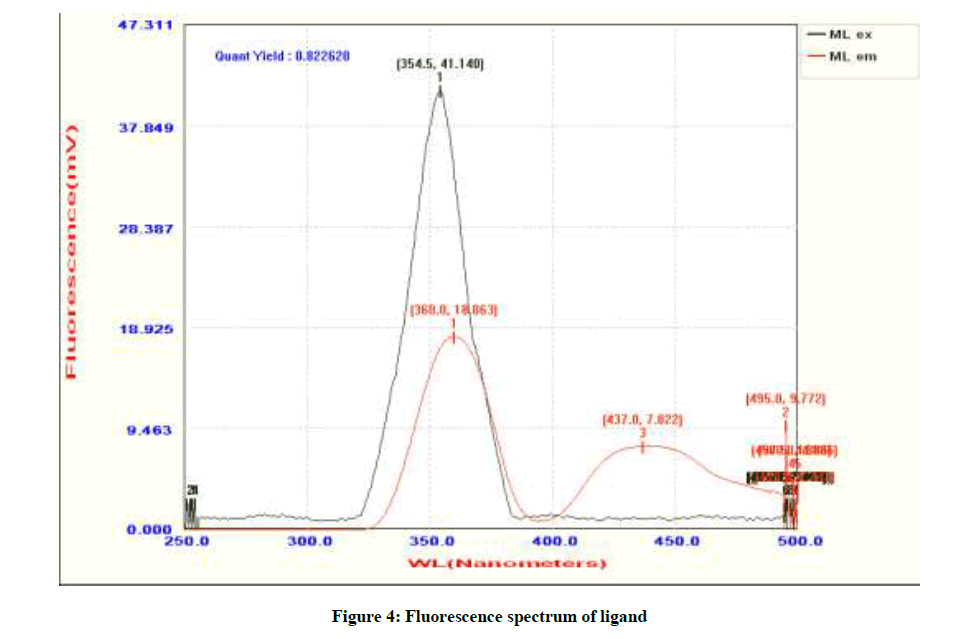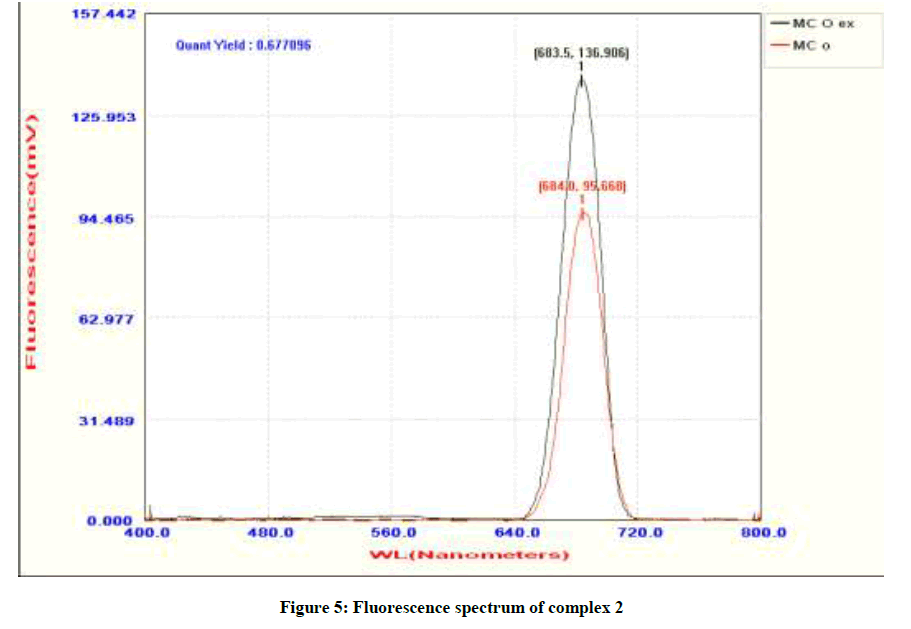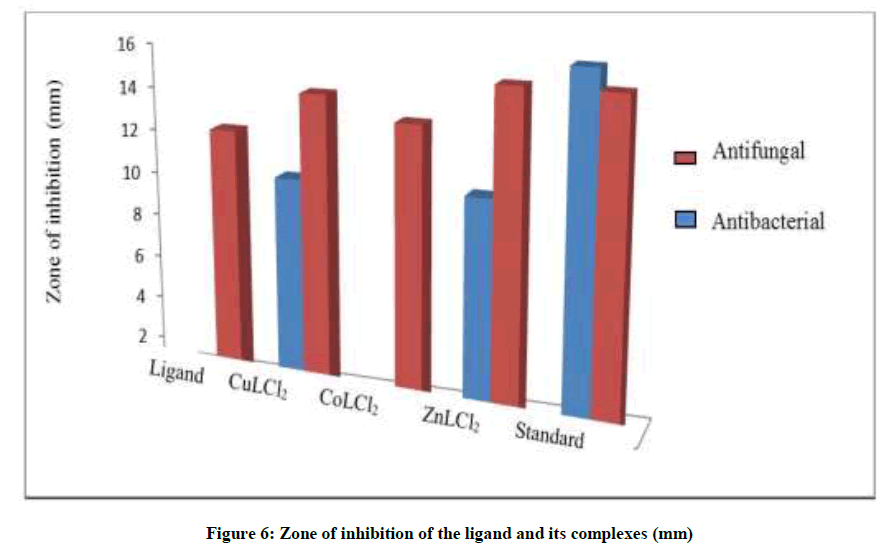Research Article - Der Pharma Chemica ( 2018) Volume 10, Issue 1
NLO and Fluorescent Behavior of a Novel Schiff Base Derived from 2,4-Diamino-6-phenyl-1,3,5-triazine and 3-(4-methoxyphenyl)-1-(thiophen-2-yl)prop-2-en-1-one and its Metal Complexes
Vathanaruba M1*, Muthukumar P1 and Tharmaraj P2
1Department of Chemistry, PG and Research, The American College, Madurai, India
2Department of Chemistry, PG and Research, Thiagarajar College, Madurai, India
- *Corresponding Author:
- Vathanaruba M
Department of Chemistry, PG and Research
The American College
Madurai, India
Abstract
A novel Schiff base N,N’-bis(3-(4-methoxyphenyl)-1-(thiophen-2-yl)allylidene)-6-phenyl-1,3,5-triazine-2,4-diamine is synthesized by the condensation reaction of 2,4-diamino-6-phenyl-1,3,5-triazine with chalcone [3-(4-methoxyphenyl)-1-(thiophen-2-yl)prop-2-en-1-one]. Metal complexes of the Schiff base ligand with molecular formula ML.Cl2 where, M=Cu(II), Co(II), Zn(II) have been synthesized and characterized on the basis of IR, magnetic susceptibility, UV-Visible, 1H-NMR, EPR spectral studies. From spectral data of the complexes, it have been tentatively assigned as square planar geometry for Cu(II), Zn(II) complexes and tetrahedral geometry for Co(II) complex. The molar conductance of the metal(II) complexes show the non-electrolytic nature of the complexes. The redox behavior of the copper(II) complex was studied by cyclic voltammetry. All the synthesized compounds may serve as potential photoactive materials as indicated from their characteristic fluorescence spectrum. The ligand–ligand charge transfer is reflected in emission spectra and is due to the presence of phenyl rings in the ligands. The nonlinear optical behaviour of the ligand and the metal(II) complexes are investigated and the second harmonic generation efficiency of the complexes have more activity than the organic ligand. The in-vitro antimicrobial activities of the compound were tested against the microorganisms the bacteria Klebsiella pneumonia and the fungi Candida albicans by well diffusion method and the result reveals that the ligand and its metal(II) complexes have significant antimicrobial activity.
Keywords
s-triazine, Schiff bases, NLO activity, Fluorescence activity
Introduction
Development of novel coordination complexes is of great research interest due to their interesting topologies and potential applications in redox system, optoelectronic devices, molecular architectures, material science, etc. [1-3]. Schiff base ligands, owing to their facile syntheses, tunable steric and electronic properties, have been extensively studied for catalysts, fluorescence properties [4,5], electroluminescent materials [6] etc. Of these Schiff bases derived from 1,3,5-triazine derivatives have been demonstrated to be versatile ligands for the synthesis of metal complex materials with a variety of structural architectures. Recently, metal-organic compounds with Nonlinear Optical (NLO) properties have been attracting a great deal of attention [7,8]. Metal-organic complexes have some advantages over the ligand such as tunability of the polarizablity by changing the oxidation state of metal atoms or by variation of ligands. 1,3,5-triazine-based ligands make a contribution to optical nonlinearity due to its aromatic triazine core and its metal ions.
Herein, we focus on a novel Schiff base containing 1,3,5- s-triazine moiety and its transition metal(II) complexes regarding the synthesis, structures, fluorescence properties, and nonlinear optical activity.
Materials and Methods
Reagents and instruments
All chemicals were obtained from Aldrich chemical & Co. and used without purification. All solvents were of AR grade and purified by standard procedure. The IR spectra in KBr disc was recorded on a Shimadzu Fourier Transform Infra-Red (FTIR) spectrophotometer. Proton Nuclear Magnetic Resonance (1H-NMR) spectrum was recorded in Deuterated Dimethyl Sulfoxide (DMSO-d6) solvent using a Bruker 300 MHz NMR spectrometer. The electronic spectra of the complexes and ligand in DMF solutions were recorded in Jasco V-530 UV-Visible spectrophotometer. The EPR spectrum of the Cu complex was recorded at 77 K in Dimethyl formamide (DMF). Cyclic voltammetry measurements were carried out by model CH 608 C instrument using a three electrode cell containing a reference Ag/AgCl electrode, Pt wire auxiliary electrode and Glassy Carbon (GC) working electrode in DMSO solution with Tetrabutylammonium Perchlorate (TBAP) used as the supporting electrolyte. Fluorescence emission spectra in the UV-Visible range were recorded in Jasco Spectro Fluorimeter FP-8500 between 400-900 nm. The ligand and its complexes were screened for antimicrobial activity through the well diffusion method.
Preparation of ligand
Synthesis of tridentate Schiff base involves refluxing 1 equivalent of 2,4-diamino-6-phenyl-1,3,5-triazine with two equivalent of chalcone in ethanol solution. An ethanolic solution of 2,4-diamino-6-phenyl-1,3,5-triazine (0.01 mol) is refluxed with 3-(4-methoxyphenyl)-1-(thiophen-2- yl)prop-2-en-1-one (0.02 mol) in ethanol for about 9 h and then keep it for a day. The yellow solid is filtered and recrystallized with ethanol and dried in vacuum over anhydrous calcium chloride (Figure 1). M.p. 180°C. Yield: 67%.
Preparation of metal(II) complexes
To the ethanolic solution of the ligand (1 mmol), metal chloride (MCl2.xH2O, 1 mmol) in ethanol is added drop wise with constant stirring. The resulting mixture was stirred for about 3 h at room temperature. The chelate separated out was filtered and dried. Yield 76%.
Results and Discussion
The results of elemental analysis (Table 1) and 1H-NMR spectrum of the ligand are consistent with the formula in Figure 1. The 1H-NMR spectra of the Schiff base ligand in DMSO-d6 shows a singlet at 3.87 ppm for -OCH3 (6H, s) proton, multiplet at 7.40-7.53 ppm for aromatic protons, doublet at 8.30 ppm for –CH proton. Molar conductivity of the metal(II) complexes in DMSO were in the range 3.0-6.50 S cm2.mol-1 indicating the non-electrolytic nature of the complexes.
| Compounds | Color | Found (calcd) (%) | M.p. (°C) | Molar conductance (S.cm2.mol-1) |
|||
|---|---|---|---|---|---|---|---|
| C | H | N | M | ||||
| Ligand (L) | Pale yellow | 69.48 | 4.53 | 10.95 | - | 180 | - |
| 69.43 | 4.49 | 10.98 | 8.01 | 3.03 | |||
| CuLCl2 (1) | Green | 57.39 | 3.74 | 9.04 | 8.2 | 128 | |
| 57.43 | 3.7 | 8.99 | 7.56 | 3.04 | |||
| CoLCl2 (2) | Blue | 57.74 | 3.77 | 9.1 | 7.67 | 111 | |
| 57.69 | 3.71 | 8.98 | 8.38 | 6.5 | |||
| ZnLCl2 (3) | Yellow | 57.26 | 3.74 | 9.02 | 8.44 | 194 | |
| 57.22 | 3.71 | 9.03 | |||||
Table 1: Physical characteristics of the ligand and metal(II) complexes
IR spectra
IR spectra for ligand and metal(II) complexes are given in Table 2. On comparing the IR spectra of the ligand with their metal complexes, stretching band at 1452 cm-1 corresponding to ν(C=N)) group in triazine ring is found to be shifted by 60-62 cm-1 in complexes indicating the coordination of C=N in the triazine nitrogen in coordination [9]. A red shift is observed in complexe for (C-S) stretching vibration around 5 cm-1 indicates thiophene sulphur in coordination with metal [10]. The appearance of weak non-ligand band in the far IR region at 561-553 cm-1 can be assigned to ν(M-N) vibration and confirm the interaction between the metal and the ligand [11].
| Compound | ν(C=N) (triazine) |
ν(C=N) | ν(C-S) | ν(M-N) |
|---|---|---|---|---|
| Ligand (L) | 1452 | 1589 | 823 | _ |
| CuL.Cl2 (1) | 1512 | 1584 | 819 | 561 |
| CoL.Cl2 (2) | 1514 | 1589 | 819 | 553 |
| ZnL.Cl2 (3) | 1514 | 1589 | 819 | 553 |
Table 2: IR spectral data of the ligand and its metal(II) complexes (cm-1)
Electronic spectra
The electronic spectrum of the ligand shows a strong intense band at 28818 cm-1 due to π → π* transition. The electronic spectrum of Cu(II) complexes (Table 3) exhibits a band at 22935 cm-1 which can be assigned to 2B1g → 2A1g transition suggests square planar geometry [12]. The electronic absorption spectrum of the cobalt (II) complex shows absorption bands at 16447 cm-1 (ν3), 9836 cm-1 (ν2) which corresponds to the transitions 4A2(F) → 4T1(P), 4A2(F) → 4T1(F) suggests tetrahedral geometry [12]. Bands v2 and v3, show a structure which is believed to be mainly due to splitting of d orbitals caused by a lowering of symmetry [13]. From the electronic spectra of the complexes, it is tentatively assigned that square planar geometry for Cu(II) complex and tetrahedral geometry for Co(II) complex (Figure 2).
| Compound | Frequency (cm-1) | Assignments | εM-1cm-1) | Geometry |
|---|---|---|---|---|
| Ligand | 28818 | π→π* | - | - |
| CuL.Cl2(1) | 22935 | 2B1g → 2A1g | 52.5 | Square planar |
| CoL.Cl2(2) | 16447 9836 |
4A2(F) → 4T1(p) 4A2(F) → 4T1(F) |
25.1 40.3 |
Tetrahedral |
Table 3: Electronic spectral data of the ligand and its metal(II) complexes
EPR spectra
The EPR spectrum of Cu(II) complex (1) at LNT shows four well resolved peaks. The anisotropic signals exhibits with g║=2.292 and g┴=2.06 which is comparable with those observed for square planar geometry. The g║/A║ value calculated for complex (1) (138 cm) lies between 90 and 140 cm indicating a square planar structure around the Cu (II) ion [14]. The trend, g║ (2.292) > g┴ (2.06) > ge (2.0023) shows that the unpaired electron lies predominantly in the dx2-y2 orbital of the copper(II) ion. The exchange interaction parameter G is estimated from the expression G=(g║-2.0023)/(g┴-2.0023). The observed G value is greater than 4 (G=4.8) for the Cu(II) complex demonstrates the negligible exchange interaction between the copper(II). The covalence parameters α2 was calculated using the following Equations:
α2 (Cu)=(A║/p) + (g║-2.0023) + 3/7(g┴-2.0023) + 0.04
The calculated α2 value (0.7269) of the complex is less than unity, which indicates the complex has some covalent character in the ligand environment [15]. The spin orbit coupling constant value λ(-571 cm-1), calculated using the relations gav=1/3(g║ + 2 g┴) and gav=2(1-2λ/10Dq), is less than the free Cu(II) ion (-832 cm-1) which also supports the covalent character of M-L bond in the complex [16].
Electrochemical behaviour
The redox behavior of Cu(II) complex in DMSO have been studied by cyclic voltammetry using glassy carbon as the working electrode, platinum wire as counter electrode, Ag/AgCl as reference electrode and Tertiary Butyl Ammonium Perchlorate (TBAP) as supporting electrolyte. The cathodic current function values were independent of scan rate. The repeated scan as well as different scan rate shows that dissociation does not take place in the complex. The cyclic voltammogram of Cu(II) complex (Figure 3) shows a well-defined redox process corresponding to the formation of the Cu(II)/Cu(I) couple at 0.44V and another at -0.641V which is attributable to the reduction of Cu(I)/Cu(0). During the reverse scan, it shows two anodic oxidation peaks at 0.71V and 1.08V which are attributable to the oxidation of Cu(0)/Cu(I) and Cu(I)/Cu(II) respectively. The ratio of cathodic to anodic peak Ic/Ia=1 corresponding to a single one electron process [17].
Nonlinear optical activity
NLO property of the material was confirmed by Kurtz powder technique to study the second harmonic generation efficiency. A comparison of the Second Harmonic Generation (SHG) signal emitted by the sample with the standard KDP under the same experimental conditions, shows that the ligand is 0.25 times than that KDP and the Cu(II) complex is 0.5 times that of KDP. The NLO properties of a molecule are related to the energy gap between Highest Energy Occupied Molecular Orbital (HOMO) and Lowest Energy Unoccupied Molecular Orbital (LUMO). The small HOMO-LUMO gap indicates small excitation energy and hence high NLO properties are predicted.
Fluorescence studies
Fluorescence is particularly favored in molecules that possess rigid structures. Therefore, influence in rigidity has been invoked to account for increase in fluorescence when complexed with metal ions. Ligand and the ccomplexes are photoluminescent in DMF solvent at room temperature, as shown in Figures 4 and 5, which which may be due to intra-ligand π → π* emission. The ligand upon excitation at 354 nm displays two broad emission bands, centered at 360 nm and 437 nm with the quantum yield of 0.8226. Complex 2, displays a relatively weak emission with λmax at 684 nm in DMF solvent at room temperature with the quantum yield of 0.677. Significant differences in the positions of emission maximum of ligand and its complexes establish the coordination of the metal ion to the ligand [18].
Antimicrobial activity
The antimicrobial activity of the ligands and their metal complexes were tested against the bacteria (Klebsiella pneumonia) and fungi species (Candida albicans) by the well diffusion method. The test solutions were prepared in DMSO. Amikacin and ketoconazole were taken as the standard antibacterial and antifungal drugs. In vitro antibacterial data reveals that the newly synthesized ligand and its complexes displayed moderate antibacterial activity. All the synthesized compounds show significant antifungal activity in comparison to the standard drugs used (Figure 6). The metal(II) complexes shows more potent activity than the free ligand due to chelation effects.
Conclusion
A novel tridentate Schiff base ligand have been prepared by condensation of 2,4-diamino-6-phenyl-1,3,5-triazine and -3-(4-methoxyphenyl)-1- (thiophen-2-yl)prop-2-en-1-one and characterized by spectroscopic studies. From spectral data of the complexes, it have been tentatively assigned as square planar geometry for Cu(II), Zn(II) complexes and tetrahedral geometry for Co(II) complex. Molar conductance of the complexes reveals that the prepared complexes are found to be non-electrolytes. Electrochemical studies of the Cu(II) complexes shows that Cu(II)/Cu(I) redox system is reversible in nature. In-vitro antimicrobial activity data also reveals that the newly synthesized compound displayed significant activity in comparison to the standard. The synthesized ligand and the ccomplexes are photoluminescent in DMF solvent at room temperature. The ligand and copper(II) complex shows significant NLO properties when compared with standard KDP. Enriched NLO activity of the Cu(II) complex than the free ligand is due the decrease in energy gap between HOMO and LUMO.
Acknowledgement
The authors are thankful to the University Grant Commission, New Delhi, for the financial support for this work. We also acknowledge the support provided by the Sophisticated Analytical Instrumentation Centre, Indian Institute of Technology, Chennai for spectral measurements.
References
- J.E. Mizzi, R.L. LaDuca, Inorg. Chim. Acta., 2014, 411, 188-198.
- Y. Yang, Q. Zhao, C. Tu, F. Cheng, F. Wan, Inorg. Chem. Commun., 2014, 40, 43-46.
- P.K. Bhaumik, S. Jana, S. Chattopadhyay, Inorg. Chim. Acta., 2012, 390, 167-177.
- S.H. Li, F.R. Chen, Y.F. Zhou, J.N. Wang, H. Zhang, J.G. Xu, Chem. Commun., 2009, 28, 4179-4181.
- S.A. Lee, G.R. You, Y.W. Choi, H.Y. Jo, A.R. Kim, I. Noh, S.J. Kim, Y. Kim, C. Kim, Dalton Trans., 2014, 43, 6650-6659.
- L. Zhou, C.C. Kwok, G. Cheng, H. Zhang, C.M. Che, Opt. Lett., 2013, 38, 2373-2375.
- D.A. Davies, J. Silver, G. Cross, P.J.J. Thomas, Organomet. Chem., 2001, 631, 631.
- I.S. Lee, H. Seo, Y.K. Chung, Organometallics., 1999, 18, 1091.
- J. Chu, W. Chen, G. Su, Y.F. Song, Inorg. Chim. Acta., 2011, 376, 350.
- A.P. Mishra, A. Tiwari, Rajendra K. Jain, Adv. Mat. Lett.,2012, 3, 213-219.
- R.M. Issa, S.A. Azim, A.M. Khedr, D.F. Draz, J. Coord. Chem., 2009, 62, 1859-1870.
- A.B.P. Lever, Inorganic Electronic Spectroscopy, Elsevier, Amsterdam 1984.
- Y. Murakami, Y. Matruda, J. Sakata, Inorg. Chem., 1971, 10, 1728.
- V.P. Daniel, B. Murukan, B.S. Kumari, K. Mohanan, Spectrochimica Acta Part A., 2008, 70, 2, 403-410.
- D. Kivelson, R.J. Neiman, J. Chem. Phys., 1961, 35, 149.
- M.F.R. Fouda, M.M.A. Elzaher, M.M.E. Shakdofa, M.F. Ayad, Transition Met. Chem., 2008, 32, 219.
- V.L.N. Diasa, E.N. Fernandesa, L.M.S. da Silvaa, E.P. Marquesa, J. Zhangb, A.L.B. Marques, J. Power Sources., 2005, 142, 10.
- A. Majumder, G.M. Rosair, A. Mallick, N. Chattopadhyay, S. Mitra, Polyhedron., 2006, 25, 1753.

